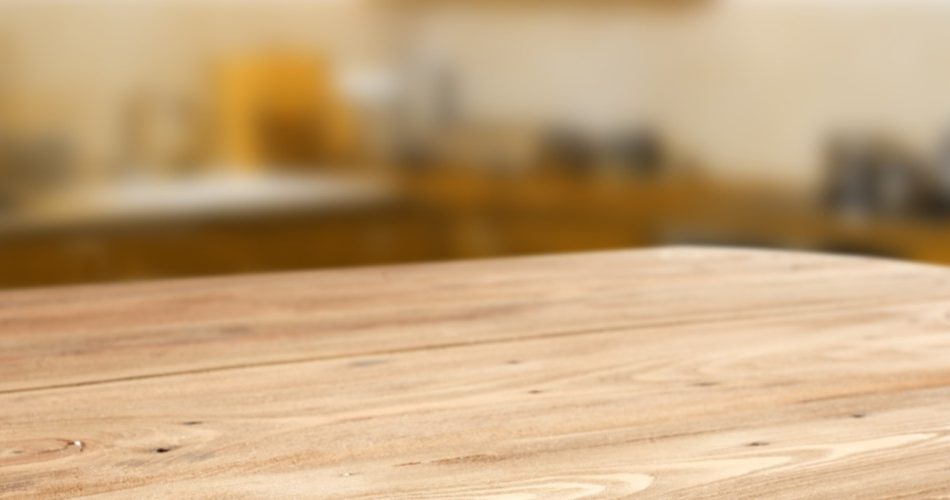Solid wooden worktops look spectacular in any kitchen – we’re big fans of the warm wood style at Kitchen Warehouse. That said, there are a lot of myths out there about the practicality of this material in the kitchen. After all, doesn’t wood rot when it gets damp?
The truth is, it’s all about how you take care of it. Maintaining your wooden kitchen worktops requires regular cleaning and oiling to keep them in good shape. Sealing your worktops with layers of protective oil and following smart practices in the kitchen will keep them safe.
We’ve compiled this informative blog to reveal everything you need to know about oiling solid wood worktops, so you can get the absolute best out of your investment. From the why to the what to the how, these top tips will help you to keep your worktops looking wonderful.
Why should you oil wooden kitchen worktops?
If you’re wondering ‘why do I need to oil my wooden worktops?’, the answer is to improve their durability and aesthetics. Wood is porous, meaning that bacteria can find its way into untreated wood and cause it to rot. Modern wooden worktop oils are formulated to fill the gaps in the grain and harden, forming a protective water-resistant barrier.

Not only does oiling your worktops prevent them from rotting, warping, or becoming discoloured, but it also enhances the natural colours of the wood grain without making them appear too shiny. While lacquers and varnishes can add an unnatural gloss, oil will lend a rich patina to the wood that continues to develop with every oil treatment.
The beauty of wooden kitchen worktops is that even if they fall into disrepair, they can be brought back to their full glory with a little TLC. Cleaning, sanding, and oiling can transform a worse-for-wear worktop back to looking brand new. Now you know how important it is to oil wooden worktops, the rest of this blog will explain how easy it is to complete this simple process properly!
Which oil should you use on solid wood worktops?
Before we tell you the best type of oil to use, you’ll need to know what you should never use to oil solid wood worktops. While olive oil is often suggested for treating wooden chopping boards, it’s not a good choice for wooden worktops. It stays wet and greasy for a while and can eventually become sticky, encouraging bacteria growth.
For similar reasons, you shouldn’t use any type of vegetable oil on your solid wood worktop surfaces. It can actually cause a build-up in bacteria leading to wood rot, making it unsuitable for food preparation. Though both oils can enhance the colour of the wood in the short-term, the long-term problems caused by olive oil or vegetable oil aren’t worth the trouble.
So, which oil is best for solid wood worktops? There are plenty of wood-safe oils to choose from – we recommend steering away from waxes, lacquers, and varnishes. Instead, look for linseed oil, tung oil, or Danish oil. Linseed oil and tung oil are great for penetrating and sealing hardwoods, but tung oil isn’t always food-safe, as it’s made from the nuts of the tung tree.
Danish oil is the most strongly recommended product for treating solid wood kitchen worktops. It’s an optimised mixture of polymerised linseed oil with varnish and added drying agents, resulting in a fast-curing finish. This hardwearing and water-resistant coating provides a satin-like surface, which is perfectly safe for food preparation areas.

How to correctly oil solid wood worktops
Once you have your suitable wooden worktop oil, the best way to apply it is simply to pour some of the oil onto the worktop in the direction of the wood grain. Use a clean and soft cloth – such as cotton or microfibre – to spread the oil across the surface until there’s an even layer. You may want to leave it for about 10 minutes before working the oil into the surface a bit more with the cloth.
This first coat of oil might dry fairly quickly, but effectively oiling a solid wood worktop requires several coats. We recommend applying 3-7 coats of oil, allowing each coat to dry fully before applying the next one. Depending on the oil you use, each coat could take around 8 hours to dry. It’s best to follow this process over a few days, allowing the subsequent coats to dry overnight.
Your worktops should have been fully oiled on all sides before installation, including the surface underneath. After they’ve been installed, you must regularly apply oil to the exposed surfaces that you can reach. Aim for 3 coats on the top, 4 coats on the edges, and 6 coats for the end grain.
Don’t be tempted to do a couple of thicker coats to save time – the point is to build up thin layers of oil which absorb deeply into the wood. You can’t over-oil wooden worktops, but you can under-oil them, so make sure you’re not being frugal or hasty with it – apply each coat thoroughly as directed.
How often should you oil solid wood worktops?
Solid wooden worktops must be sanded and oiled on all surfaces prior to installation. Following installation, it’s a good idea to start building up those oil layers by oiling your wooden worktops at least once a week for the next 6 weeks. Applying the oil shouldn’t take more than 10-15 minutes for each coat, so it’s not a time-consuming task.
After the first 6 weeks, you should get into the habit of regularly oiling your solid wood worktops at least 3-4 times a year. Re-applying oil every 3 months or so should ensure that your worktops retain their water-resistant and resilient properties. This will prevent the wood from bowing or warping, and the colour will continue to mature over time.
As we’ve said, you can’t really over-oil a wooden worktop, so technically you could oil your worktops as often as you like. However, every 3 months is frequent enough to keep them in good condition for years to come. After the first few months, anything more often is just making more work for yourself, so don’t worry about it too much.
A good way to test whether it’s time to apply more oil is to spill a small amount of water on them (and clean it up afterwards, of course!). Your solid wood worktops should have a sheen to them, and water should bead up on the surface. If they’re dull, and water doesn’t form into droplets on them, then it’s definitely time to re-oil your wooden kitchen worktops.
How to maintain real wood worktops
In addition to regular oiling, it’s important to keep wooden worktops clean to prevent staining and bacteria growth. Food preparation areas and worktops near the kitchen sink tend to be at greater risk of spillages, and the last thing you want is rotting wood and black mould.
The very nature of kitchens makes it inevitable that various substances will be spilled on the worktops. Whenever this happens, wipe up the spill as quickly as possible with a clean and dry cloth. Never allow liquids to pool on the surface for any length of time. Be especially careful with pigmented spices, such as paprika and turmeric, which can easily stain the worktops.
To prevent scratching or scorching your solid wood worktops, avoid cutting directly on them – always use a chopping board. Don’t put wet or dirty pots and pans down on the surface, especially if they’re hot. Use trivets or kitchen surface protectors if you need to place hot pots and pans on the counters. If scratches or marks do occur, you can usually buff them out by sanding them, before re-oiling the wooden worktop.
When cleaning your worktops, never use abrasive materials like scouring pads or harsh chemical products. It’s best to simply use a damp cloth and a mixture of warm water and soap to wipe down the surfaces. If you need something stronger, you could try diluting white vinegar in the water. For a more pleasant-smelling mixture, you could use lemon juice.
Are real wood worktops a good choice?
If you’re on the fence about getting real wooden worktops now you know that you have to oil them, we’ll be the first to tell you that they’re definitely worth it. Well-oiled wooden countertops add warmth and colour to the kitchen, still looking as good as new years after installing them. There are so many benefits of using solid wood in your kitchen.
Did you know that when you order wooden worktops, you could ask for the section of wood that’s cut out to make room for the sink? This piece of wood often goes to waste, when it can be cleaned up and turned into a free matching cutting board! You’ll be able to prepare food in style without damaging the solid wood counters underneath.
Wooden kitchen counters look great with most kitchen styles, from solid oak to Shaker. If you’re on the lookout for stylish kitchen units and kitchen doors to go with your new solid wood worktops, be sure to check out the selection from Kitchen Warehouse. Our team would be happy to help and provide more information about our products – simply get in touch by calling 01765 640 000 or by sending us an email at contact@kitchenwarehouseltd.com.




